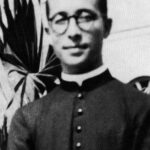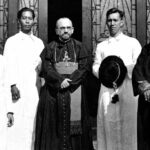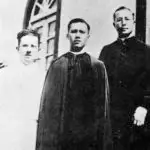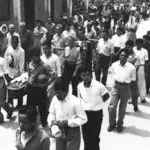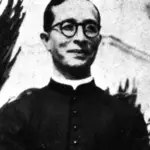Father Jesus Baza Duenas
An heroic martyr
Father Jesus Baza Duenas (1911 – 1944) was the second CHamoru/Chamorro to be ordained a priest. He led the Catholic Church during the Japanese occupation of Guam during World War II and was later killed by the Japanese in July of 1944.
Duenas was born on 19 March 1911, the son of Luís Paulino Duenas and Josefa Martínez Baza. In 1926 he left for the San Jose Seminary in Manila, where Guam was sending its students for the priesthood. Duenas was ordained a priest at the Agaña Cathedral on 11 June 1938, by Bishop Miguel Ángel Olano, OFM Cap. in the first priestly ordination celebrated on Guam.
As a new priest, he remained in Hagåtña as an assistant and as director of a group of young men preparing to go to the seminary in Manila.
Duenas’ boldness was manifested when the Japanese first invaded Guam in December 1941. According to reports, Duenas rounded up some Inalåhan men, where he was then stationed, to resist the Japanese, although they soon gave up that plan.
When the Japanese exiled all the American missionaries on Guam in January of 1942, Duenas and the newly-ordained Father Oscar L. Calvo were left behind as the only two Catholic priests allowed on island, since they were both CHamorus. Duenas and Calvo agreed to share responsibilities for the island, with Duenas taking care of the south, headquartered at Inalåhan.
In late 1942, Bishop Olano, in Japan, wrote to Duenas appointing him temporary head, or Pro-Vicar, of the church on Guam in the bishop’s absence. This letter was carried to Guam by a Japanese monsignor, Dominic Fukahori, who was accompanied to Guam by another Japanese priest, Father Petro Komatsu. These two priests were asked by the Japanese government to come to Guam.
Duenas did not welcome them and considered them to be agents of the Japanese. Fukahori did, in fact, go about the island in the company of the Japanese officials and speak to CHamoru audiences about the benefits of Japanese rule. It must be added that Fukahori did this at the request of the Japanese authorities, one that could not be denied without personal risk.
For his part, Duenas did what he could to stand up to injustice whenever he saw it. At meetings with the Japanese officials, Duenas would bring up cases of Japanese improprieties and abuse of CHamorus. Duenas quickly became a thorn in the side of the Japanese. He would hum American songs and read American magazines in public. He was also accused of spreading rumors of the Japanese defeat of Saipan.
When Fukahori spoke to a congregation in Inalåhan in the absence of Duenas, Duenas wrote an irate letter to him in protest. Fukahori showed the letter to Father Calvo, commenting that, should the letter be forwarded to the Japanese officials, Duenas would most certainly be punished and perhaps exiled to Rota or Tinian. However, Calvo managed to convince Fukahori to keep the letter to himself.
But it was Duenas’ alleged knowledge of the whereabouts of George Tweed, an American navy radioman, that was his biggest liability. Tweed had escaped capture by the Japanese, aided by numerous CHamorus who assisted him. Rumors circulated that Duenas knew about Tweed’s movements because CHamorus would confide in him.
On 8 July 1944, Duenas was arrested in Inalåhan. For several days he was brutally beaten and tortured, and pressed for information he supposedly had about Tweed. Duenas remained silent. His nephew, former Island Attorney Edward Duenas, was also beaten and tortured alongside the priest.
From Inalåhan, Duenas and his nephew were sent to Agaña Heights where the Kempeitai (Japanese military police) had their headquarters. A man named Joaquin Limtiaco, who was at the site where the priest and his nephew were held, suggested to Duenas that they take advantage of the sleeping guards and flee, but Duenas declined, saying he had done no wrong and that God would look after him. It is possible that this refusal was due to the certainty that the Japanese would punish the families of escapees and possibly those who they suspected of helping them.
Early on the morning of 12 July, the two were moved to Ta’i, Mangilao, to the field station of the Japanese agricultural unit, the Kaikontai. There, Duenas and his nephew Edward Duenas were beheaded. Two other CHamoru men, Juan Pangelinan and an unidentified man, were also executed in the same manner along with the Duenas’.
After the war ended, an interpreter from Saipan who was a witness of the beheading, took Father Calvo and others to the grave site in March of 1945. The body of Father Duenas was exhumed and then buried anew in the sanctuary of his parish church in Inalåhan. In 1948, Guam Bishop Apollinaris Baumgartner began a Catholic minor seminary and high school at Ta’i, near the site of the priest’s brutal murder, and named the institution Father Duenas Memorial School where it remains today.
For further reading
Father Dueñas Memorial School. “History.”
“First Ordination on Guam.” Guam Recorder, July 1938.
Guam War Survivors. “Home.” Last modified 27 June 2021.
Palomo, Tony. “A Man of Courage and Conviction.” In Liberation-Guam Remembers: A Golden Salute for the 50th Anniversary of the Liberation of Guam. Maite: Guam 50th Liberation Committee, 1994.
–––. An Island in Agony. Self-published, 1984.
Sullivan, Julius, OFM Cap. The Phoenix Rises: A Mission History of Guam. New York: Seraphic Mass Association, 1957.

